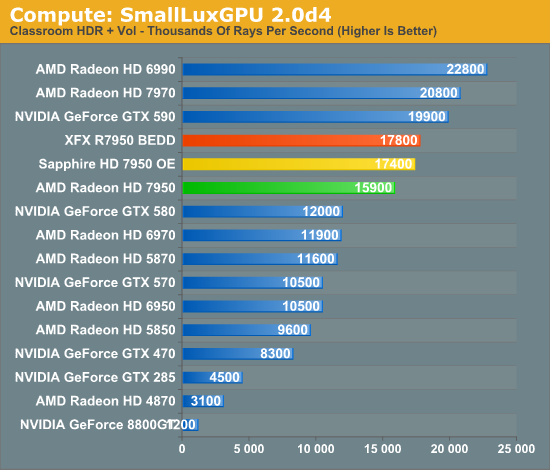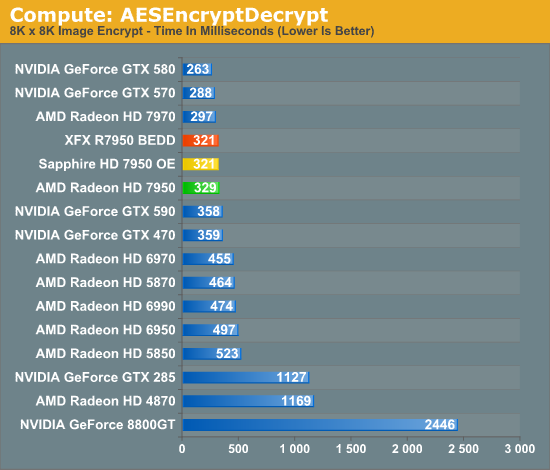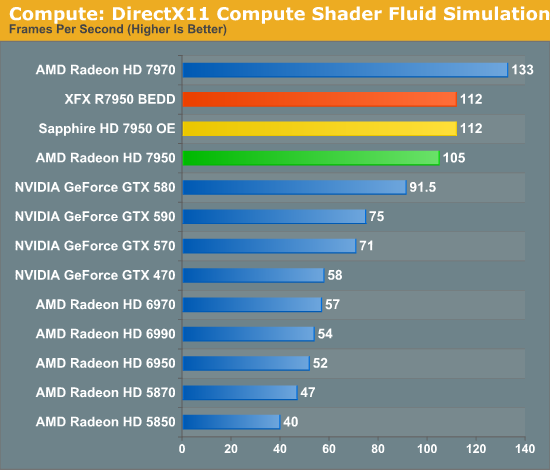AMD Radeon HD 7950 Review Feat. Sapphire & XFX: Sewing Up The High-End Market
by Ryan Smith on January 31, 2012 9:02 AM ESTCompute Performance
Moving on from our look at gaming performance, we have our customary look at compute performance. Since compute performance is by definition shader bound, the 7950 is at a bit of a disadvantage here compared to gaming performance. Whereas ROP performance scales with the core clock, shader performance is hit by both the reduction in the core clock and the disabled CU array.
Our first compute benchmark comes from Civilization V, which uses DirectCompute to decompress textures on the fly. Civ V includes a sub-benchmark that exclusively tests the speed of their texture decompression algorithm by repeatedly decompressing the textures required for one of the game’s leader scenes. Note that this is a DX11 DirectCompute benchmark.

AMD’s greatly improved compute performance continues to shine here, though in the case of Civilization V it’s largely consumed by just closing the previously large gap between the GTX 500 series and the Radeon HD 6000 series. As a result the 7950 falls ever so short of the GTX 580, while the factory overclocked Sapphire and XFX cards give the 7950 enough of a push to come within 5% of the 7970.
Our next benchmark is SmallLuxGPU, the GPU ray tracing branch of the open source LuxRender renderer. We’re now using a development build from the version 2.0 branch, and we’ve moved on to a more complex scene that hopefully will provide a greater challenge to our GPUs.

Under SmallLuxGPU the 7970 enjoyed a large lead over the GTX 580, and this continues with the 7950. Even though the 7950 is well behind the 7970—to the tune of 24%—it’s still 33% ahead of the GTX 580 and the lead only grows from there. Meanwhile the XFX and Sapphire cards can catch up to the 7970 somewhat, but as this is truly a shader-bound test, you can’t make up for the lack of shaders units on the 7950.
For our next benchmark we’re looking at AESEncryptDecrypt, an OpenCL AES encryption routine that AES encrypts/decrypts an 8K x 8K pixel square image file. The results of this benchmark are the average time to encrypt the image over a number of iterations of the AES cypher.

In spite of being a compute benchmark, AESEncryptDecrypt is not particularly sensitive to GPU performance, showcasing the impact that setup times can have. The 7950 trails the 7970 by 10%, and overclocking doesn’t change this much. Unfortunately for AMD NVIDIA is still the leader here, showing that AMD’s compute performance still has room to grow.
Finally, our last benchmark is once again looking at compute shader performance, this time through the Fluid simulation sample in the DirectX SDK. This program simulates the motion and interactions of a 16k particle fluid using a compute shader, with a choice of several different algorithms. In this case we’re using an (O)n^2 nearest neighbor method that is optimized by using shared memory to cache data.

With the compute shader fluid simulation we once again shift back into a compute task that’s much more shader-bound. The 7950 only reaches 80% of the performance of the 7970, once more proving the real impact of losing a CU array. This is still enough to handily surpass the GTX 580 however, with the 7950 taking a 15% lead.










259 Comments
View All Comments
chizow - Wednesday, February 1, 2012 - link
Perhaps, but judging by Newegg's current stock of 7950, supply is exceptionally good or demand is exceptionally soft for this product at its current price. Maybe somewhere in the middle?But as you said, if you don't like it, don't buy it and it seems in this case, capitalism works just fine. ;)
Gamer23 - Wednesday, May 2, 2012 - link
I was drooling when I first read about the Sapphire 7950 and the XFX 7950 DD, but now until AMD developes better drivers, I am still on the fence, and holding on to my 5850 Toxic. I believe most people are like me, $500? I'll sit back and wait, till I see better driver support, and a $300 dollar price tag! I believe you are right also about demand being soft, as I believe most purchases are fresh builds not upgrades.Gamer23 - Wednesday, May 2, 2012 - link
I totally agree with you, I am running a i7 940 with a 5850 Toxic, and even with all of the latest games that have recently come out, I am not even pushing this rig yet. Since games are now being locked at 60 fps, what's the sense of spending $500 for the latest and greatest and only getting 60 fps? Until game developers pull off the 60 fps govenor, (catering to console ported games) it will be a while yet before I am ready to let go of this Video card.xeridea - Tuesday, January 31, 2012 - link
I totally agree. I have a 6850 I got at a very good price. It runs any game on the market reasonably well. I run Crysis 2 with DX11 patch and texture patch @ 2048x1152 with reasonable framerates (I think my dual core is my bottleneck, usually I only get ~70% GPU utilization). I used to get cards slightly higher in generation performance, but these days it doesn't really matter with mostly crappy console ports.chizow - Tuesday, January 31, 2012 - link
I agree for the most part, but there are at least 3 major influences pushing game technology:1) Increases in VRAM usage in current games. Whether its due to MSAA, higher-res textures and texture mods, games like Skyrim, BF3, Metro 2033, Crysis 2 are really chewing up VRAM budgets on cards. These games will use 1.5GB no problem at 1080p, so just imagine higher resolutions or muti-display set-ups.
2) As mentioned, multi-display set-ups like EyeFinity or Nvidia Surround. They'll use up ~3x the VRAM as a single monitor and with increased AA requirements, that quickly adds up. In these instances, a 7950/7970 would shine over last-gen parts with less VRAM and bandwidth.
3) 3D. 1080p isn't that demanding anymore, but 1080p in 3D is roughly double the rendering requirements but puts an even greater emphasis on maintaining 60FPS minimums. Its really quite demanding and an area more GPU horsepower is always welcome, even with SLI/CF configs.
But yes, other than these niche areas there's probably not too much reason to upgrade at this point, especially when these offerings don't really shift the price/performance/value bar at all.
kashifme21 - Tuesday, January 31, 2012 - link
Well from personal experience i have GTX 580 in SLI. Both the cards have 1.5gb memory.I game at a resolution of 5760*1080. Unless i shift the AA to some crazy setting like 8x AA, my VRAM generally isnt a bottleneck.
I am currently playing a game like Skyrim at 5760*1080. Maxed out settings with 4X AA, FXAA & 4xTRAA
My game is mostly running locked at 60fps, sometimes in towns it does drop down to 45fps, however otherwise the experience is quite smooth.
Hence i would disagree that VRAM really is a limitation even at insanely high resolutions, 1.5GB Vram is pretty dam good.
Now with the next consoles only expected to be sporting GPUS like 6670, i wonder how Nvidia and AMD intend to keep both markets alive.
At one hand they support console gaming which doesnt really bring them too many chips a year and it will eventually cause PC gamers to stop upgrading. The business model looks like its going to axe their own feet.
chizow - Tuesday, January 31, 2012 - link
You must not run any texture mods at all, because Skyrim will use 1.5GB at only 1080p with only 2xMSAA+2xTSAA.Same for BF3, Crysis 2, Metro 2033 and quite a few other games with just highest-res official textures and 4xMSAA+2-4xTSAA.
JarredWalton - Tuesday, January 31, 2012 - link
I have a single 1.5GB GTX 580, and at 2560x1600 I definitely feel the lack of VRAM. If he doesn't notice lack of RAM at 5760x1080, I don't trust his judgement. (Hint: it's the minimum frame rates and stutters that come from the lack of memory; averages can be fine, but minimums often tank.)Sabresiberian - Tuesday, January 31, 2012 - link
Thanks Jarred for talking about performance where it counts, minimum frame rates and stutters.;)
chizow - Wednesday, February 1, 2012 - link
Yeah I completely agree about "feeling" the lack of VRAM, because it literally feels like I've submerged my mouse/monitor in oil or molasses. Idk the input lag and stutters from deferred AA just gets really unbearable once you start exceeding VRAM.But yeah I dropped a note in Ryan's 7970 closer look about PCIe bandwidth, VRAM and memory bandwidth. It'd be interesting to see how much of an impact PCIe bandwidth plays a role on cards with less VRAM, since that's when you'd expect more paging to system RAM over the PCIe bus. Also for memory bandwidth, although that's more between the GPU and RAM modules.
Anyways would be interesting to see something like that done using 1.5/3GB variants maybe a 580 and the 7950 when the 1.5GB arrives?